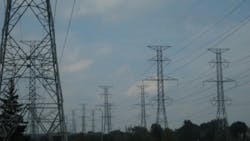New Transmission Construction - Is It Worth the Investment?
A reader recently asked:
The latest nuclear radiation leak news from Japan and US EPA regulations on coal plants would seem to petty much seal the fate of large base-load plants in the US. It looks to me like we're moving mostly to dispersed renewables and smaller gas combined cycle. But then I read where transmission construction spending is going up - over $50 billion in the next couple of years. Isn't that just following the same old central generation/large transmission paradigm we've had for a century? Isn't there a real danger of having stranded transmission assets? What am I missing here?
The short answer is that many of the best renewable resources -- where you get the most output per acre or per dollar invested -- are not close to where people live.
It is true that distributed renewables like rooftop solar are growing fast and may come to provide a big chunk of our energy. Still, there are two major reasons for complementing local generation with some long-distance transmission capacity. One is to access those superior wind and solar resources to bring down the cost of bulk electricity. The other reason is to share resources among larger regions as a backup against local problems or shortages. These motivations are the same as what drove the geographic expansion and interconnection of the grid over the past century; the logic still applies even for an all-renewable resource base.
One thing that has changed, though, is what we can now do with technology to store, manage and condition power. So it's fair to ask, how does the investment in long-distance transmission compare to what it would take to provide that same level of power quality and reliability through local means? Either way, we are committing ourselves to some major long-term infrastructure investments. For example, you could imagine many autonomous microgrids, tailored to local resources and needs, with storage and flexible options for managing demand. At today's costs, most people in the industry would say that such a small-scale option is way more expensive than building out transmission links. (Some would argue that while it may cost more, the local approach would also be more resilient against all kinds of disasters -- but that's a topic for another day!)
Of course, costs change over time, and the trend may be toward favoring the more local style. You might also ask what social values are represented by different styles of infrastructure investment. On the one hand, we have self-sufficiency and a "small is beautiful" approach. On the other hand, we have the idea of broad equality -- that citizens everywhere should have access to the same reliable electricity at a fair price. Keep in mind that the most beautiful, advanced microgrids with uninterruptible power supplies don't necessarily crop up in low-income neighborhoods. These are not easy questions. Luckily, it seems that small- and large-scale approaches, with today's technology, are not mutually exclusive; instead, most would say that we need some of both.
So, back to your question: Is it possible that by spending big on transmission, we're saddling ourselves with a new round of stranded assets? Pretty unlikely, in my opinion. As long as transmission lines lead to sunny and windy places and not to coal plants, we'll probably have pretty good use for them for many years to come.
On another note: a lot of future long-distance transmission may be high-voltage d.c., for reasons of electrical stability. It's possible to convert a.c. lines to d.c., so we're not painting ourselves into a corner -- but it's worth thinking strategically about the type of transmission we want to build, which also includes how they look and impact the environment (for example, where do we put them underground?). And that means deciding just how much money we're prepared to spend.
About the Author
Alexandra von Meier, PhD
Co-Director for Electric Grid Research, California Institute for Energy and Environment
Dr. Alexandra “Sascha” von Meier is Co-Director for Electric Grid Research at the California Institute for Energy and Environment (http://uc-ciee.org), and Adjunct Associate Professor in the Department of Electrical Engineering and Computer Science at UC Berkeley. She currently studies technical and operational issues related to the integration of high levels of renewable resources in electric grids, particulary through through advanced instrumentation of power distribution circuits that increases their visibility to operators. Her past research has addressed engineering and cultural dimensions of energy technology, including electric power distribution, grid-connected photovoltaics, electric demand response, nuclear power plant operation, nuclear materials management, and green building performance. Her textbook, Electric Power Systems: A Conceptual Introduction (Wiley-IEEE, 2006), has been used in university courses and industry to help explain the complexities of operating the electric grid. An award-winning educator, she regularly presents tutorials on electric power delivery to academic and professional audiences. Sascha received her Ph.D. in energy and resources (1995) and her B.A. in physics (1986) from the University of California, Berkeley. Away from the office, she enjoys cycling, rock climbing and the mountains whenever possible.
